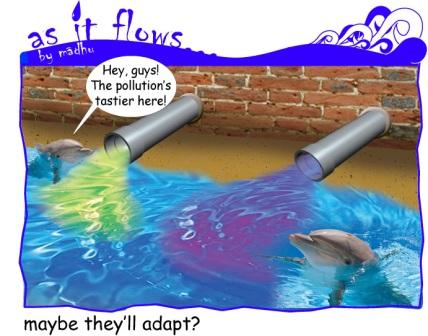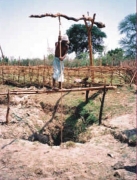Contamination, Pollution and Quality
Environment flows - Continuing the discussion
Posted on 21 Jul, 2010 12:41 AM
Transportation behavior of lindane in different types of soil – A research report by National Institute of Hydrology
Posted on 17 Jul, 2010 09:37 AMThe report deals with the transportation behavior of lindane, a pesticide used commonly in the agricultural and public health sectors in India, through sandy and loamy soils. The contamination of groundwater by pesticides is a worldwide problem because of their tissue degradation and carcinogenic nature. They are bio-accumulative and relatively stable and therefore, require close monitoring.
The pesticides used for agricultural, forestry and domestic activities leach into the groundwater and therefore, it is very important to study their transportation behavior in different types of soil media.
Distribution of heavy metals on sediments under different flow conditions in the river Hindon, UP – A research report by National Institute of Hydrology
Posted on 17 Jul, 2010 09:26 AMThe study deals with the distribution of heavy metals on sediments under different flow conditions in the river Hindon. The river is subjected to varying degree of pollution caused by numerous untreated waste outfalls of municipal and industrial effluents.
Development of reaeration coefficient for Indian condition using mathematical approach and field studies – A research report by National Institute of Hydrology
Posted on 16 Jul, 2010 11:16 PMThe report deals with development of reaeration coefficient for Indian condition using mathematical approach and field studies. Of the various constituents, which determine the quality of water, Dissolved Oxygen is the most important parameter indicating the health of a stream. There is a continual replenishment (reaeration) or utilization (deoxygenated) of Dissolved Oxygen due to inflow of waste load at different points in the stream. When a waste load is discharged into a flowing stream, it is mainly subjected to advection, dispersion and reaction kinetics. Waste Load Allocation (WLA) studies provide information to assist in making effective decisions on levels of treatment required for a source or sources of pollutant loads.
A rapid geohydrological study of microwatersheds from Bolangir district, Orissa state - A report by ACWADAM
Posted on 16 Jul, 2010 03:50 PM This document by ACWADAM is a report of a rapid geohydrological assessment of some of the microwatersheds from parts of Bolangir district Orissa.
This document by ACWADAM is a report of a rapid geohydrological assessment of some of the microwatersheds from parts of Bolangir district Orissa.
Bolangir district in Orissa forms a part of one of the hottest and backward regions of India with low land-productivity, and opportunities and technologies for agriculture in the district remain relatively unexplored.
Vagaries of rainfall and the underlying hard-rock geology further compound the problem and limit agricultural productivity to a great extent. Given such natural uncertainties, systematic implementation of a watershed management programme is the most viable avenue to overcome the problems of this region.
Bolangir district was thus selected as pilot area to conduct a pre-feasibility exercise for planning of water resources management. ACWADAM, Pune was invited, along with Samaj Pragati Sahayog, Bagli to conduct this pre-feasibility exercise.
Bio-drainage – A research report by National Institute of Hydrology
Posted on 12 Jul, 2010 07:32 PMThe report attempts to provide solutions to the twin problems of waterlogging and salinity in the irrigated command area through various drainage or traditional reclamation measures viz controlling the intensity of irrigation, providing drainage system, lining, improving natural drainage, preventing seepage or adopting modern technology for application of water.
History of water filters - Past, present and future of water filtration technology
Posted on 11 Jul, 2010 02:16 PMThe History of Water Filters website, has interesting and useful information on water filters, water treatment alternatives and water quality.
A study of saline freshwater interface phenomena in the Mahanadi delta region (Orissa)
Posted on 10 Jul, 2010 10:40 PM The subsurface aquifer systems in Mahanadi delta region in Orissa (India) is largely characterized by two groups of freshwater aquifer systems, both of which are prone to saline water mixing/migration with time and development:
The subsurface aquifer systems in Mahanadi delta region in Orissa (India) is largely characterized by two groups of freshwater aquifer systems, both of which are prone to saline water mixing/migration with time and development:
- The south western Mahanadi delta region is represented by unconfined to semi-confined freshwater aquifers underlained by brackish/saline aquifer systems with a diffusion boundary.
- The north eastern parts of Mahanadi delta is represented by deep freshwater confined aquifers overlained by brackish/saline water aquifers with aquitard/ aquiclude boundary.
A baseline survey of groundwater quality in coastal aquifers of Andhra Pradesh - A research report by National Institute of Hydrology
Posted on 10 Jul, 2010 01:09 PMThe study provides an analysis of groundwater quality to identify probable pollution or contamination in coastal aquifers of Kakinada in Andhra Pradesh. Sampling surveys have been conducted in the months of May 99, August 99 and November 99 and about 186 water samples were collected from shallow wells, filter points, canal water and rainwater. The spatial and temporal variations of water quality parameters are presented in the report.
Draft regulatory framework for wetlands conservation - Comments by ATREE
Posted on 09 Jul, 2010 11:49 PMThe Ministry of Environment and Forests released a draft of the regulatory framework for wetland conservation - Wetlands Conservation and Management Rules (2009) for feedback from all stakeholders. The draft framework was prepared by a multi-disciplinary expert group, and final round of comments were invited till June 21st 2010.
The Wetland Conservation Team of Ashoka Trust for Research in Ecology and the Environment (ATREE) did a detailed analysis of the draft regulation and submitted several pertinent concerns to the Ministry. The most significant observation is that the new framework (as do much of India's policies and laws) continues to propose unjustifiable State control and interventions over the country's wetlands and livelihoods of people dependent on them. The regulation does not make any constructive suggestions or recommendations for the conservation that the country's wetlands demand, and instead brings all wetlands into complete official control by installing Central, State and District-level wetland regulatory authorities, wherein the majority of the members will be senior government officials.





